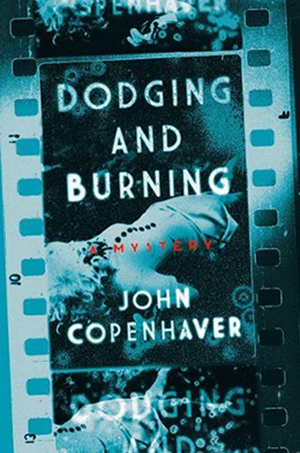There are few things as exciting to a reader as discovering an author at the beginning of their career. That sense of the unknown in palpable and once it is clear that the writer has the skills to captivate and entertain, the wonder at the magic of it all is insurmountable. Debut novels hold this special place in the hearts of fans and Dodging and Burning by John Copenhaver is just the sort of work that history will look back on as a moment when a legacy was born.
On the widest possible level, John Copenhaver’s Dodging and Burning is crime fiction featuring LGBTQ+ themes, however to pigeonhole it as simply that is to vastly under-appreciate this fine novel. Dodging and Burning is a historical novel depicting the coming-of-age of several different characters during a time when their moments of self-discovery clash with the ideologies of the larger community. By juxtaposing the harsh realities of life in 1945 (as World War II comes to an end) with the innocence of the two main female characters, Copenhaver is able to elucidate the emotions involved when childhood fantasy collides with unvarnished reality. The fallacy of the perfect youthful romance – of all permutations – is shattered as the ominous winds of maturity sweep through and taint each character in different ways. Furthermore, the decision to have the majority of the novel unravel in retrospect allows the author to interject some important insights that would only have become evident with the passage of time.
 This manipulation of the timeline allows for past, present, and future to weave themselves together into a whole-cloth tapestry in which the removal of any one thread would unspool the entire design. Even though Dodging and Burning features two alternating narratives voices – those of the two girls, Bunny Prescott and Ceola Bliss – it is really the story of four people and the society they inhabit. Readers learn about Jay Greenwood solely through the differing eyes of each female narrator. It is another skillful move on the author’s part to have the final corner of this structural foundation remain the most elusive. Robbie Bliss – who left for war, never to return – is brought to life via memory, diary, and dime-store pulp writings. Not unlike the photographs that play such a crucial role in the story, interpretation of events and actions are filtered through the eyes of the beholder – and further analyzed by the reader, who remains on the outside looking in.
This manipulation of the timeline allows for past, present, and future to weave themselves together into a whole-cloth tapestry in which the removal of any one thread would unspool the entire design. Even though Dodging and Burning features two alternating narratives voices – those of the two girls, Bunny Prescott and Ceola Bliss – it is really the story of four people and the society they inhabit. Readers learn about Jay Greenwood solely through the differing eyes of each female narrator. It is another skillful move on the author’s part to have the final corner of this structural foundation remain the most elusive. Robbie Bliss – who left for war, never to return – is brought to life via memory, diary, and dime-store pulp writings. Not unlike the photographs that play such a crucial role in the story, interpretation of events and actions are filtered through the eyes of the beholder – and further analyzed by the reader, who remains on the outside looking in.
That Dodging and Burning is essentially a crime novel cannot be ignored. The questions of who killed Lily Vellum and why her body disappeared after Jay took a photograph of it carry the narrative forward with many dramatic shifts before the truth is ultimately revealed; but there is so much more knowledge to be gleaned from watching the evolution of these characters as history swirls around them. As is so often true in real life, no one comes out unscathed.
Dodging and Burning is a masterwork of tone and voice. The central themes are heavy and could easily have weighed down the story – straying into pedantic territory – but because there is the constant sense of discovery and youthfulness, the reader never worries about that. John Copenhaver keeps control of his complex narrative by nailing the voices of these two very different girls.
Fans of the pulp writings of that era will delight in finding the novel’s progression occasionally interrupted (or is it enhanced?) by a story from one such pulp publication – designed and typeset very cleverly by Pegasus Books. This tale could just as easily stand on its own as a successful short story, but when woven into the larger novel’s text, readers will understand the true impact on both its author and the characters reading it – not to mention the effect on the reader of the novel. Dodging and Burning will linger in the minds of fans for a long time; a beacon for voices too often stifled, both then and now.
Pre-order Links: Dodging and Burning by John Copenhaver

Wow, this sounds amazing so I just ordered it!
Thanks Gale. It was one of my favorite books from last year and I am so happy that it will soon be available to readers